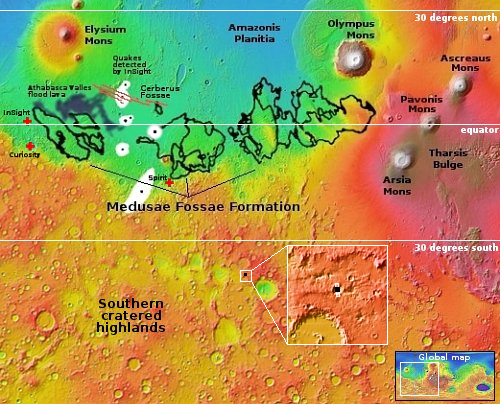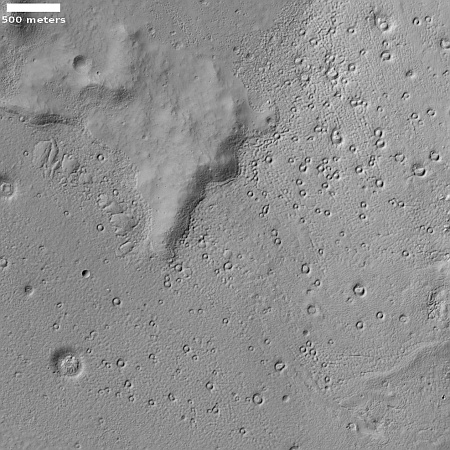Martian mounds surrounded by moats
Cool image time! The picture to the right, cropped, reduced, and sharpened to post here, was taken on February 1, 2023 by the high resolution camera on Mars Reconnaissance Orbiter (MRO). It shows what the camera team labels “Circular Mounds Surrounded by Moats,” which when all the known data is considered are probably caused by a spray of small meteorites landing on a field of ice.
Why ice? The location is at 37 degrees south latitude, in the cratered southern highlands of Mars, where many images show glacial-type features inside many craters. In fact, all the nearby craters at this location appear to have such features, suggesting the presence of near-surface ice trapped in these craters.
The picture actually looks at the floor of another such crater, with the mounds in the image’s upper left the crater’s indistinct central peaks. Though only 8.5 miles wide, the crater is deep, with interior walls that quickly rise 2,800 feet to the rim. That depth further suggests ice, as any snow that fell here in the far past could easily become trapped, inside what could be thought of a cold trap.

The black dot in the inset on the overview map to the right marks this location. It seems to me that this spray of meteorites were likely secondary ejecta from another larger impact nearby. Hot from that impact, the rocks melted that ice, the rocks sunk slightly, and were left as we see them.
At least, that’s my guess. There are certainly other possibilities. What reinforces this hypothesis for me is seen in the full image, where there is one crater on top of one of the mounds inside the crater. suggesting this spray of impacts came after the ice was emplaced.
On Christmas Eve 1968 three Americans became the first humans to visit another world. What they did to celebrate was unexpected and profound, and will be remembered throughout all human history. Genesis: the Story of Apollo 8, Robert Zimmerman's classic history of humanity's first journey to another world, tells that story, and it is now available as both an ebook and an audiobook, both with a foreword by Valerie Anders and a new introduction by Robert Zimmerman.
The print edition can be purchased at Amazon or from any other book seller. If you want an autographed copy the price is $60 for the hardback and $45 for the paperback, plus $8 shipping for each. Go here for purchasing details. The ebook is available everywhere for $5.99 (before discount) at amazon, or direct from my ebook publisher, ebookit. If you buy it from ebookit you don't support the big tech companies and the author gets a bigger cut much sooner.
The audiobook is also available at all these vendors, and is also free with a 30-day trial membership to Audible.
"Not simply about one mission, [Genesis] is also the history of America's quest for the moon... Zimmerman has done a masterful job of tying disparate events together into a solid account of one of America's greatest human triumphs."--San Antonio Express-News
Cool image time! The picture to the right, cropped, reduced, and sharpened to post here, was taken on February 1, 2023 by the high resolution camera on Mars Reconnaissance Orbiter (MRO). It shows what the camera team labels “Circular Mounds Surrounded by Moats,” which when all the known data is considered are probably caused by a spray of small meteorites landing on a field of ice.
Why ice? The location is at 37 degrees south latitude, in the cratered southern highlands of Mars, where many images show glacial-type features inside many craters. In fact, all the nearby craters at this location appear to have such features, suggesting the presence of near-surface ice trapped in these craters.
The picture actually looks at the floor of another such crater, with the mounds in the image’s upper left the crater’s indistinct central peaks. Though only 8.5 miles wide, the crater is deep, with interior walls that quickly rise 2,800 feet to the rim. That depth further suggests ice, as any snow that fell here in the far past could easily become trapped, inside what could be thought of a cold trap.

The black dot in the inset on the overview map to the right marks this location. It seems to me that this spray of meteorites were likely secondary ejecta from another larger impact nearby. Hot from that impact, the rocks melted that ice, the rocks sunk slightly, and were left as we see them.
At least, that’s my guess. There are certainly other possibilities. What reinforces this hypothesis for me is seen in the full image, where there is one crater on top of one of the mounds inside the crater. suggesting this spray of impacts came after the ice was emplaced.
On Christmas Eve 1968 three Americans became the first humans to visit another world. What they did to celebrate was unexpected and profound, and will be remembered throughout all human history. Genesis: the Story of Apollo 8, Robert Zimmerman's classic history of humanity's first journey to another world, tells that story, and it is now available as both an ebook and an audiobook, both with a foreword by Valerie Anders and a new introduction by Robert Zimmerman.
The print edition can be purchased at Amazon or from any other book seller. If you want an autographed copy the price is $60 for the hardback and $45 for the paperback, plus $8 shipping for each. Go here for purchasing details. The ebook is available everywhere for $5.99 (before discount) at amazon, or direct from my ebook publisher, ebookit. If you buy it from ebookit you don't support the big tech companies and the author gets a bigger cut much sooner.
The audiobook is also available at all these vendors, and is also free with a 30-day trial membership to Audible.
"Not simply about one mission, [Genesis] is also the history of America's quest for the moon... Zimmerman has done a masterful job of tying disparate events together into a solid account of one of America's greatest human triumphs."--San Antonio Express-News



There are the “Circular Mounds Surrounded by Moats“, and the distinct “Impact Craters” formed in different era’s in Mars distant past. The difference existing side-by-side in the immediate location might be important?
Although I agree with your guess, especially the hot ejecta as an plausible explanation for foaming the ice/mud, pushing up and away from the hot fragments, then refreezing and settling back into a mound with a moat…
Especially when the unusual moat phenomenon only occurs in the “glacier style fluid driven wall collapse” that flows down and fills the crater floor, as distinguished by the soft “ice cream melting” edges and flow lines.
When walls collapse at work, there’s often heat and steam escaping from the flow as it generates a lot of friction.
Due to the large size of this “Highwall failure”, an alternative guess, is the high friction heat melting the water table fluid substance into the mud that covers the crater floor… but also creating bubbles of steam/gas/air that come to the surface pushing/displacing the apron of fluid and mud around each bubble, (faintly visible) freezing in place then retreating/settling back down when the slide begins to cool creating the ring or moat that would also get deeper as evaporation consumes the ice. I admit, I’ve seen such formations in bubbling sulfur/glass/ metal or hot mud on earth, so I’m trying to make a connection using mostly imagination, but that doesn’t necessarily mean anything on Mars.
But then it could be a combination of the two scenarios that the impact nearby knocked the wall down creating the mud flow that the hot ejecta landed in? Timing and circumstances perfect for this formation? This is fun.